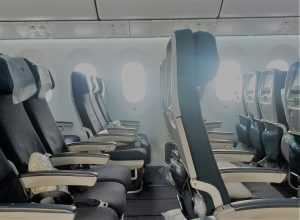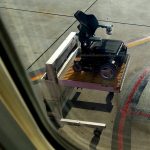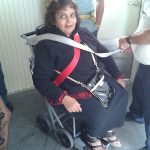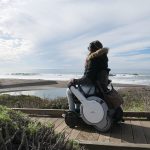Is it safe to fly? Before planning a trip that includes travel on an airplane, talk to your child’s doctor about whether it’s safe to fly. Know how long it is safe to fly, address any concerns or precautions, and come up with a manageable plan.
Have the doctor provide a signed note on office letterhead that clearly addresses the child’s disabilities and abilities. Special adaptions, accessories, and medications are to be approved and signed off by the physician as necessary for your child’s nutrition and survival.
 Mental Preparation
Mental Preparation
Now that the doctor has given clearance to fly, be your child’s advocate and know your rights.
Have an honest perspective on the overall goal. The goal is to safely get from A to B without any incidents that will make the 11 o’clock news. Expect the worst, and then be pleasantly surprised when you arrive as well as all your stuff. For example, it’s a real possibility that you may have to give Diastat on the airport floor, change a g-tube over the Atlantic Ocean, or even have to haul a bag of soiled clothes off an airplane.
Packing
Create a checklist of supplies and medications needed for the time traveling. An airline cannot charge a fee for luggage containing any medical supplies. It’s illegal! *
Photocopy the doctor’s signed letter along with the list of medications and supplies, and place this packet inside a clear Ziplock bag for protection. Scotch tape the bag to the inside of the luggage, right on the top, so it’s clearly visible to a TSA agent if opened. Repeat if additional luggage is used, including the doctor’s letter.
Prepare for the unexpected, and pack extra vital items that may be hard to acquire at the destination. Though it’s more expensive, it’s easier to purchase common supplies, like diapers, wipes, hygiene care, etc. after arrival, since there’s already a lot of luggage to bring. Some items, such as suction catheters, that are changed every day at home, may be able to last a bit longer on a temporary basis while traveling, which can minimize the luggage load. Shipping supplies in advance, to a hotel for instance, is another strategy to consider, but be sure to track the package and confirm when it has arrived and that it will be stored in a secured location.
For the carry-on, dedicate a small, rolling suitcase with all your child’s medications and feeding supplies. Include a change of clothes and a few big Ziplock bags to seal soiled clothing.
*Based on lots of personal experience, consider boxing up all the needed medical equipment. If it’s in a suitcase, TSA may still think it is just clothing and try to charge you, even when it’s a bag of diapers.
Reserving a Plane Flight
Check if your airline has a department for travelers with special circumstances requiring special accommodations. If so, call and speak to a well-trained and informed representative about what’s needed to ensure a safe flight and book your reservation. It’s a refreshing experience compared to trying to explain a detailed medical condition to a regular reservationist.
To get started, the key phrase is “My child is severely disabled and needs “FULL ASSISTANCE.” If you and your child have traveled before, let them know. “My child has traveled aboard countless times, and does well on the flight as long as a few accommodations are met.” Also, explain you’ll be traveling with medical supplies and that you know your rights, so they cannot charge you extra for baggage with medical supplies.
Provide the airline with details about the wheelchair. You’ll be asked questions like, Is the wheelchair battery-operated or manual? What kind of battery is used? And, is your child able to walk or stand? If not, are you able to carry your child to the seat or require the usage of an aisle chair? *
When selecting a seat, be clear and honest about what’s needed and why. For instance, “My child can only sit in the aisle wheelchair for a few minutes, so please assign a seat closest to the plane’s main cabin door. The bulkhead is the most obvious and preferable seating location, since it’s the closest and most spacious, especially if there is a code-brown and a diaper change is needed.”
*An aisle chair is a narrow chair on wheels that can squeeze down the plane’s narrow aisle.
Check-In
When checking in for your flight and getting the tickets, you’ll be asked to provide some information. First of all, remind the ticket agent that you will need “assistance” maneuvering throughout the airport, including security. Inform the ticket agent that you choose to “gate-check” your child’s wheelchair, as opposed to placing it in baggage claim and using a generic airport wheelchair. The ticket agent will also ask about the make and model of the wheelchair, as well as its condition, including scratches. Before leaving the ticket counter, an agent will attach a personal tag to the wheelchair with the information provided (different from the gate-check tag).
Do you need an airport attendant to push your child to the waiting area of the plane’s gate or will you be doing it yourself? Make sure it’s noted that an aisle chair is scheduled to appear to board the plane. “My child needs an aisle chair to get from the plane’s door to his assigned airline seat, with two shoulder-style safety belts and a lap belt, otherwise, he’ll fall out.” Do you need trained assistance to transfer your child or will you be doing it yourself? Also at check-in, let the airline know that you want help deplaning and getting to baggage claim or connecting to another flight.
TSA Screening
TSA Cares is a program that specifically assists travelers with disabilities, medical conditions, and other special circumstances during the security screening process. You can call 72 hours prior to traveling to get questions answered about screening procedures and what to generally expect going through the TSA security checkpoint. If you have concerns, TSA Cares can provide a passenger support specialist officer. After checking in, dial the officer’s cell phone number you were provided in advance. You will skip waiting in the security checkpoint line, and be directly escorted to a private screening area.
Before the screening process gets going, tell them up front that you are traveling with a lot of liquids. When boxes or luggage are opened, make sure the medical packet copy is clear and visible for TSA. Have patience with the TSA agent as they go through items and question you. No need to get offended when they test for chemicals and other explosive materials on the wheelchair, feeding pump, etc., this is just our world today.
Boarding the Plane
Pre-boarding is set up at the plane’s gate desk, not at check-in, though a reminder a check-in doesn’t hurt. Approach the gate desk to inform them that you are flying with a disabled child and need to pre-board using an aisle chair as well as to gate-check the child’s personal wheelchair. The wheelchair gets a second, brightly-colored tag indicating that it’s gate-checked, and you are given the corresponding claim ticket.
Ask the attendant for the time pre-boarding will occur, in case you leave the area. It’s a good idea to stay close by, visible to the staff, in case your pre-boarding needs are forgotten or some other change. Many U.S. Airlines have a designated, pre-boarding area closest to the gate. Tell the attendant that time above all is what really helps, and to please not let the other passengers board until completely situated because they are just going to have to wait otherwise. Boarding a plane is such a “hurry up and wait” scenario. You’re going to sit on the tarmac anyway, so just don’t stress getting your child seated and the equipment stored where you want.
At the plane’s cabin door, you must transfer your child from the wheelchair to the aisle chair (provided by the airport). This is best, since only you know the intimate details regarding the safest way. Many aisle chairs don’t have chest-straps, only a seatbelt, so if needed, simply ask the airport attendant to go get another one or you will sue the pants off them when your child falls out. Say it nicely; this works. Even though you must transfer your child, an airport attendant is then required to push your child down the aisle to the assigned seat. Watch your child’s arms so that they don’t hit the armrests when rolling down the very narrow aisle. Once at the assigned seat, you have to transfer your child out of the aisle chair.
Onboard the Plane
Surround your child with airline pillows and blankets for support, and bring a travel neck pillow for the head. Place the rolling, carry-on suitcase with all the child’s supplies under the seat for foot support. Occasionally during the flight, try to move (stretch) the child’s arms and legs to prevent discomfort and stiffness; gentle massage is also beneficial and promotes circulation. Using a feeding pump on airplanes can be tricky, but it’s possible. Use a D-clip, hair-tie, or rubber band to attach the feeding bag to the tray of the seat in front of you. It works!
Ask your child’s gastroenterologist and dietitian what can be done to avoid a code-brown change on travel day. One suggestion is to give the child Pedialyte for 24 hours before flying. There will be #1’s to change, but hopefully avoid a code-brown, though there are no guarantees. If a code-brown occurs, just very politely tell your seatmate sorry, but a diaper change is required and will likely be odorous. It is what it is. Suggest to your seatmate to take this moment to stand up and walk around a bit. The majority of people are kind and understanding.
Departing the Plane
At check-in, remind the ticket agent that you need help getting from the airplane to the baggage area, or to connect to a flight. It’s also recommended that you also remind flight attendants of this need on the actual airplane at the start and end of the flight. Flight attendants have a demanding job, so help them by giving them friendly reminders. Kindness is key.
After the plane stops at the gate, prepare to be the last passengers off the plane. Sometimes if you have a connecting flight, you may be able to get off sooner, but no guarantees. When deplaning, the child’s wheelchair should be right outside the main door, if you gate-checked the wheelchair. Don’t get off the plan unless the wheelchair has arrived.
Leaving the airport: call in advance and arrange a wheelchair-accessible van if you can!

 Mental Preparation
Mental Preparation 









